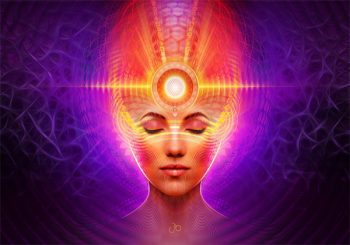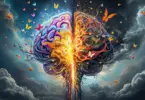Guest Writer for Wake Up World
There are many myths and stories about the pineal gland; thought by some to be the mystical seat of the soul. This tiny organ in the brain has been the center of many spiritual musings, and the focus of countless spiritual practices. People are enthusiastic about the connection between plant medicines like ayahuasca and the pineal gland.
[pro_ad_display_adzone id=”110028″]
Why are we so interested in the pineal gland, and how is it related to ayahuasca?
The pineal gland
There are three important glands in your brain, producing hormones that are transported around the body to keep everything working normally. They are the pituitary gland, the hypothalamus, and the pineal gland. The pineal is only about the size of a long grain of rice, but has a very important role in the body.
The pineal gland’s main function is to make the hormone melatonin, which helps to regulate sleep patterns. When we don’t have enough melatonin, we may struggle to sleep properly.
The pineal gland used to be a light-sensing organ in ancient vertebrate ancestors, and in some species of amphibians and reptiles it still acts as a kind of very basic eye. In humans and most other vertebrates, the pineal gland no longer directly senses light, but still responds to light levels and helps to regulate our circadian rhythms.
In 1637, famous philosopher René Descartes wrote that the pineal gland was “the principal seat of the soul and the place in which all our thoughts are formed.” Long before Descartes, Hinduism and Buddhism were teaching of the mystical Third Eye – representing a state of enlightenment and awareness beyond the mundane.
In contemporary culture, the pineal gland is considered by some to be a literal version of the Third Eye mentioned in Eastern religions, and a source of mystical power. This is due to a combination of Descartes’ interest in the pineal gland, and the evolutionary origins of the pineal gland as a sensory organ.
Does the pineal gland make DMT?
DMT, or dimethyltryptamine, is a powerful natural psychedelic substance that is found in many plants. It’s also usually an important part of the sacramental brew ayahuasca, which most commonly contains DMT as well as other hallucinogenic substances.
As soon as the effects of DMT were first discovered by Western scientists in the 1950s, people started wondering if it could be present in human brains. It is, afterall, similar in structure to the important neurotransmitter serotonin, and our brains could theoretically have the required machinery to make it.
In the now famous 2010 documentary “DMT: The Spirit Molecule,” researcher Rick Strassman proposed that the pineal gland was the most likely candidate for a part of the brain that could make DMT. This led to a boom of interest in the pineal gland, and the idea that DMT could be linked to mystical and religious experiences throughout human history.
So is it possible that DMT, the substance that gives ayahuasca some of its power, is made in the brain? Is the pineal gland a likely source? And what function could DMT have in our bodies?
Our brains have the machinery to make DMT
Although DMT has been found in the brains of rats and other animals, we still have no conclusive proof that the human brain can make DMT too. Previous studies have found trace amounts of DMT in our urine and cerebrospinal fluid (a protective covering of the brain), but there have been no solid findings of DMT in the brain itself.
If our brains make DMT, there would need to be two specific enzymes in the same place. AADC (aromatic L-amino acid decarboxylase) converts tryptophan (an amino acid found in all living things) to tryptamine, and INMT (indole-N-methyltransferase) converts tryptamine into DMT. Both AADC and INMT would need to be near each other in the brain in order to make DMT from tryptophan.
We know that both AADC and INMT are present in human brains. But we do not yet know if they work together to produce DMT in significant quantities.
We may not need the pineal gland to make DMT
DMT has been found in small quantities in the pineal gland of the rat, but has also been found all throughout the rat brain. One recent study showed that when the pineal gland was removed from the rat brain, they were still capable of making the same amount of DMT.
This suggests that although the human pineal gland might make DMT, it’s quite likely that the entire brain could make it too.
Could DMT be a neurotransmitter?
There’s also the question of what DMT would do in the human brain, if it was being made naturally.
It’s possible that it would be working as a neurotransmitter, like serotonin; moving around the brain and changing the behavior of neurons. However it would have to be made in quite high volumes for this function. Research in rats has shown that DMT is at levels as high as that of serotonin, so it’s possible!
If DMT isn’t made in high quantities, there’s a chance that it could still be having an effect in the brain. Psychedelic microdosers rely on tiny doses of psychedelics to give them subtle but beneficial effects on their minds.
Some people also speculate that DMT is only released by the brain during intense spiritual or mystical experiences. One study in rats has shown that when they are made to have a heart attack, their brains release large quantities of DMT. We also know that ayahuasca can be very similar to the near-death experience… So it’s possible that DMT is linked to religious and spiritual experiences, even when ayahuasca is not involved.
To summarize:
- Our brains have the machinery to make DMT
- Right now, there is no conclusive evidence that the human brain makes DMT in large quantities
- The pineal gland may not even be needed to make DMT
- We don’t know what function naturally-made DMT could have
Pineal gland calcification – not as scary as it sounds
As we age, our pineal glands naturally get a layer of calcification. This is a thin deposit of calcium that builds up and may affect the function of the pineal gland. Many organs in our body accumulate calcium deposits as we age, and it’s not necessarily harmful.
Spiritual and wellness circles are very interested in pineal gland calcification, claiming that a calcified pineal gland can interfere with your spiritual evolution and psychic wellbeing. Treatments and remedies for calcified pineal glands are found everywhere on the internet.
While there’s no conclusive evidence that pineal gland calcification is bad for your soul, it could be hurting your body. Some research suggests that a highly calcified pineal gland could reduce the amount of melatonin it is capable of making, which could cause sleeping problems.
Reduced melatonin levels could also increase the risk of migraine, schizophrenia, and Alzheimer’s – however, melatonin supplements are an effective way of treating low melatonin, and would work in people suffering from pineal gland calcification.
Although we don’t know for sure what causes calcification of the pineal gland, risk factors may include inflammation (such as stress or bad diet), and high levels of fluoride. Rates of pineal gland calcification are highly variable: around 40% of 17-year-olds have calcification on their pineal glands, and the average calcification seems to increase until the age of 60, when it generally starts to decrease.
If you’re concerned about preventing or reducing pineal gland calcification, the most effective treatments will involve a good diet, frequent exercise, and meditation. These have all been shown to help boost melatonin levels, and can also reduce inflammation to potentially reverse any calcification.
Other than surgical methods, there are no supplements that have been proven to reduce pineal gland calcification. Some people have claimed that plant medicines like ayahuasca can decalcify the pineal gland, but there is no evidence of this yet. Psychedelics like ayahuasca have been shown to have anti-inflammatory effects, so it’s possible that ayahuasca could help keep the pineal gland free of calcification.
Ayahuasca and the pineal gland
So how does everything we know about DMT and the pineal gland connect to ayahuasca?
The only thing we know so far about the pineal gland and DMT is that the pineal gland may have the capability of producing DMT, but the whole human brain may also be able to make it. In the end, the pineal gland might only produce melatonin and nothing more.
We also know that ayahuasca is more complicated than just DMT. Even when ayahuasca is made using plants that contain DMT, the brew also contains molecules such as harmine, harmaline and tetrahydroharmine, which all have unique (and slightly psychedelic) properties.
So really, there’s not a whole lot we can say about the relationship between ayahuasca and the pineal gland. Any claims you hear about a connection between ayahuasca and the pineal gland are at best speculation, and at worst completely false!
The risk of going too far down the road of chemistry, or anatomy, is that you lose sight of the wider meaning held within plant medicines like ayahuasca. The point of developing a Third Eye is to see through the veil of ordinary perception and into the ultimate truth of reality. It’s not necessarily about finding its precise location in a squishy organ (if that’s even possible).
As we learn more about DMT, the pineal gland, and ayahuasca, there will be many opportunities for distraction, and searches for holy grails. What will stay the same is that the answer to spiritual questions will almost always be nuanced, holistic, and incomplete.
Also by Patrick Smith:
About the author:
Patrick Smith is a writer and biologist who has been working in the psychedelic community for over five years. He currently writes for EntheoNation.
[pro_ad_display_adzone id=”110027″]







